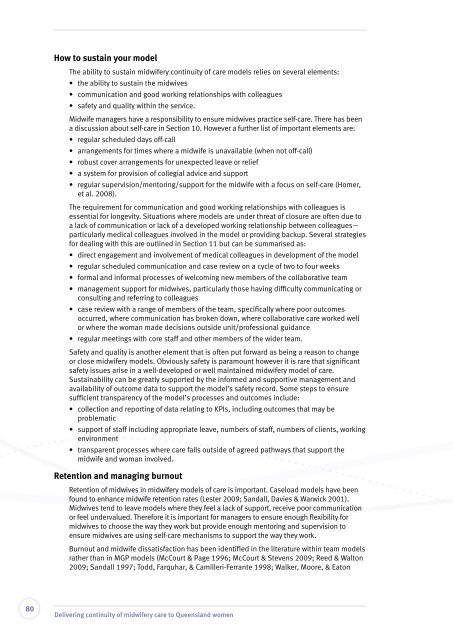Delivering continuity of midwifery care to Queensland women
Delivering continuity of midwifery care to Queensland women
Delivering continuity of midwifery care to Queensland women
You also want an ePaper? Increase the reach of your titles
YUMPU automatically turns print PDFs into web optimized ePapers that Google loves.
How <strong>to</strong> sustain your model<br />
The ability <strong>to</strong> sustain <strong>midwifery</strong> <strong>continuity</strong> <strong>of</strong> <strong>care</strong> models relies on several elements:<br />
• the ability <strong>to</strong> sustain the midwives<br />
• communication and good working relationships with colleagues<br />
• safety and quality within the service.<br />
Midwife managers have a responsibility <strong>to</strong> ensure midwives practice self-<strong>care</strong>. There has been<br />
a discussion about self-<strong>care</strong> in Section 10. However a further list <strong>of</strong> important elements are:<br />
• regular scheduled days <strong>of</strong>f-call<br />
• arrangements for times where a midwife is unavailable (when not <strong>of</strong>f-call)<br />
• robust cover arrangements for unexpected leave or relief<br />
• a system for provision <strong>of</strong> collegial advice and support<br />
• regular supervision/men<strong>to</strong>ring/support for the midwife with a focus on self-<strong>care</strong> (Homer,<br />
et al. 2008).<br />
The requirement for communication and good working relationships with colleagues is<br />
essential for longevity. Situations where models are under threat <strong>of</strong> closure are <strong>of</strong>ten due <strong>to</strong><br />
a lack <strong>of</strong> communication or lack <strong>of</strong> a developed working relationship between colleagues—<br />
particularly medical colleagues involved in the model or providing backup. Several strategies<br />
for dealing with this are outlined in Section 11 but can be summarised as:<br />
• direct engagement and involvement <strong>of</strong> medical colleagues in development <strong>of</strong> the model<br />
• regular scheduled communication and case review on a cycle <strong>of</strong> two <strong>to</strong> four weeks<br />
• formal and informal processes <strong>of</strong> welcoming new members <strong>of</strong> the collaborative team<br />
• management support for midwives, particularly those having difficulty communicating or<br />
consulting and referring <strong>to</strong> colleagues<br />
• case review with a range <strong>of</strong> members <strong>of</strong> the team, specifically where poor outcomes<br />
occurred, where communication has broken down, where collaborative <strong>care</strong> worked well<br />
or where the woman made decisions outside unit/pr<strong>of</strong>essional guidance<br />
• regular meetings with core staff and other members <strong>of</strong> the wider team.<br />
Safety and quality is another element that is <strong>of</strong>ten put forward as being a reason <strong>to</strong> change<br />
or close <strong>midwifery</strong> models. Obviously safety is paramount however it is rare that significant<br />
safety issues arise in a well-developed or well maintained <strong>midwifery</strong> model <strong>of</strong> <strong>care</strong>.<br />
Sustainability can be greatly supported by the informed and supportive management and<br />
availability <strong>of</strong> outcome data <strong>to</strong> support the model’s safety record. Some steps <strong>to</strong> ensure<br />
sufficient transparency <strong>of</strong> the model’s processes and outcomes include:<br />
• collection and reporting <strong>of</strong> data relating <strong>to</strong> KPIs, including outcomes that may be<br />
problematic<br />
• support <strong>of</strong> staff including appropriate leave, numbers <strong>of</strong> staff, numbers <strong>of</strong> clients, working<br />
environment<br />
• transparent processes where <strong>care</strong> falls outside <strong>of</strong> agreed pathways that support the<br />
midwife and woman involved.<br />
Retention and managing burnout<br />
Retention <strong>of</strong> midwives in <strong>midwifery</strong> models <strong>of</strong> <strong>care</strong> is important. Caseload models have been<br />
found <strong>to</strong> enhance midwife retention rates (Lester 2009; Sandall, Davies & Warwick 2001).<br />
Midwives tend <strong>to</strong> leave models where they feel a lack <strong>of</strong> support, receive poor communication<br />
or feel undervalued. Therefore it is important for managers <strong>to</strong> ensure enough flexibility for<br />
midwives <strong>to</strong> choose the way they work but provide enough men<strong>to</strong>ring and supervision <strong>to</strong><br />
ensure midwives are using self-<strong>care</strong> mechanisms <strong>to</strong> support the way they work.<br />
Burnout and midwife dissatisfaction has been identified in the literature within team models<br />
rather than in MGP models (McCourt & Page 1996; McCourt & Stevens 2009; Reed & Wal<strong>to</strong>n<br />
2009; Sandall 1997; Todd, Farquhar, & Camilleri-Ferrante 1998; Walker, Moore, & Ea<strong>to</strong>n<br />
80<br />
<strong>Delivering</strong> <strong>continuity</strong> <strong>of</strong> <strong>midwifery</strong> <strong>care</strong> <strong>to</strong> <strong>Queensland</strong> <strong>women</strong>
















